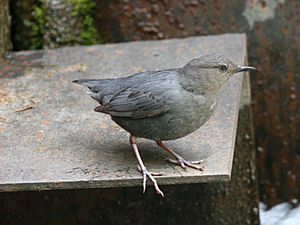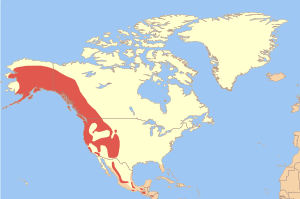American dipper facts for kids
Quick facts for kids American dipper |
|
|---|---|
 |
|
| Conservation status | |
| Scientific classification | |
 |
|
| Distribution map |
The American dipper (Cinclus mexicanus) is a special bird found in North and Central America. People sometimes call it a water ouzel. This bird is dark grey and looks a bit chunky. Its head might have a brownish tint. It has cool white feathers on its eyelids. When it blinks, its eyes flash white!
This bird is about 16.5 centimeters (6.5 inches) long. Its wings can spread out to 23 centimeters (9 inches). On average, it weighs about 46 grams (1.6 ounces). The American dipper has long legs. It often bobs its whole body up and down. It does this while looking for food in fast-moving, rocky streams. You can find these birds in the mountains. They live from Panama in Central America all the way to Alaska in North America.
Contents
What is an American Dipper?
The American dipper is a unique bird that loves water. It's known for its amazing ability to walk and swim underwater. This bird can even dive into icy streams to find its next meal!
How are Dippers Special?
Like other dippers, this species has a special extra eyelid. It's called a "nictitating membrane". This eyelid helps the bird see clearly when it's underwater. It also has scales that close its nostrils. This keeps water out when the bird dives. Dippers also make more oil than most birds. This oil helps keep them warm and dry when they are searching for food in cold water.
What Does a Dipper Sound Like?
The American dipper's song is made of high whistles or trills. It sounds like peee peee pijur pijur repeated a few times. Both male and female dippers sing. They sing all year long, no matter the season!
Where Do Dippers Live?
The American dipper usually stays in one area. It is a permanent resident. This means it doesn't migrate far. If the weather gets too cold, it might move a little south. Or it might go to lower places to find food. It also needs to find water that isn't frozen.
Why Are Dippers Important?
The presence of the American dipper shows that the water quality is good. This bird is an indicator species. If you see dippers, it means the stream is clean and healthy. Sadly, they have disappeared from some places. This happens because of pollution or too much dirt in the streams.
How Do Dippers Behave?
The American dipper protects its home along streams. It has a "linear territory." This means it defends a long, narrow strip of the stream. Its habits are very similar to the white-throated dipper in Europe. That bird is also sometimes called a Water Ouzel.
How Do Dippers Raise Their Young?
The American dipper builds a nest that looks like a globe. It has an entrance on the side. They build their nests close to water. You might find a nest on a rock ledge or a river bank. Sometimes, they build them behind a waterfall or under a bridge!
A female dipper usually lays 2 to 4 white eggs. She sits on the eggs herself. This is called incubation. The eggs hatch after about 15 to 17 days. The young birds stay in the nest for another 20 to 25 days. After that, they are ready to fly. The male dipper helps feed the young birds. The oldest American dipper ever recorded lived for 8 years and 1 month! Scientists know this from special bird bands.
What Do Dippers Eat?
The American dipper eats insects that live in water. It also eats their larvae (young forms). This includes dragonfly nymphs and small crayfish. They also eat caddisfly larvae. Sometimes, they might eat tiny fish or tadpoles.
Dippers dive underwater to find their food. This means they can sometimes become food for larger fish. Big salmonids like bull trout or Dolly Varden trout might try to eat them.
See also
 In Spanish: Mirlo acuático norteamericano para niños
In Spanish: Mirlo acuático norteamericano para niños




